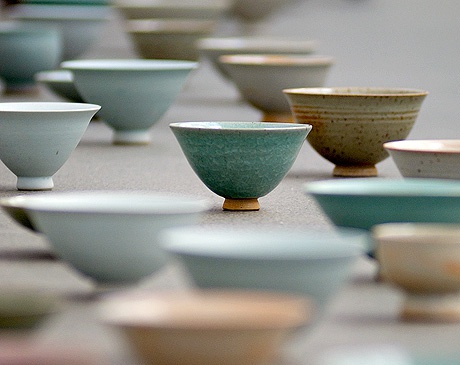POST-GAUGUIN — within the framework of the 11th Biennial ‘Towards Values’ — the exhibition co-organised by Archdiocese Museum

Participants:
Nicole Ahland (Germany)
Wojciech Ćwiertniewicz (Poland)
Wojciech Gilewicz (Poland)
Ireneusz IR Kulik (Germany)
Kamil Kuskowski (Poland)
Marek Kuś (Poland)
Young-Jae Lee (Korea)
Wojciech Łazarczyk (Poland)
Jadwiga Sawicka (Poland)
Grzegorz Sztwiertnia (Poland)
Guy Vandenbranden (Belgium)
The exhibition is divided in two parts. Works by Bożenna Biskupska and Marek Kuś are presented at the Archdiocese Museum in Katowice. Works by other artists are shown at the BWA Contemporary Art Gallery in Katowice.

‘Post-Gauguin’ — a collection of texts and works examining the subject of 'irresistible and compulsive imaging' ‘In Where Do We Come From? What Are We? Where Are We Going To? Paul Gauguin has constructed a cultural allegory of fate and a linguistic ellipse....

‘Post-Gauguin’ exhibition tour for the hearing-impaired We invite you on 18th April at 4.30 pm. The April “Post-Gauguin” exhibition tour within the framework of the 11th Biennial will take on the form of...

‘Post-Gauguin’ exhibition tour with the curator All welcome on 13th April at 2 pm for a guided tour with Roman Lewandowski, the curator and author of the “Post-Gauguin” exhibition within the 11th...

we invite you to the workshops The April artistic expression workshops refer to the “Post-Gauguin” exhibition, which has been organised within the framework of the 11th Biennial “Towards...

When in 1898 Paul Gauguin ended to paint his picture Where Do We Come From? What Are We? Where Are We Going To? on the isle of Tahiti, he was experiencing a personal crisis, and his work on it was to be a summary of his thoughts and views on life, art and the surrounding reality. Actually, in the picture we can see the metaphoric take of the history of human existence which spreads between mythical figures of childhood, youth and old age. Figures and the divinity are situated in the picture in lonely groups, as if creating separate islands that manifest affirmation, dream and melancholy. However, the inverted direction of narration is the most surprising fact; Gauguin shows the space of life and death, the beginning and the end, in reversed order, as if a reflection in the mirror. This intriguing change of array and symmetry is probably an attempt at contesting the ethnocentric paradigm that dominates the visual and textual culture of the West. The narration of the picture — just like in ancient Hebrew texts — is running from the right to the left. This proves Gauguin’s conceptual approach to the language and themes of painting rather than the illustrative character of the theme. In general, the practice of reading from the right to the left is characteristic for Arab, Semitic and Far East languages. In this case, however, the artist wanted clearly to refer himself to the first biblical manuscripts in which, among other things, we can find the description of the creation of the world. They have probably been the inspiration and it was from them that Gauguin has drawn the theme and the procedure of directing the image writing. The painter has included all the traces of gestuality in the archetype of the Book and in the module of existential writing. In result, the picture plays the role of text and vice versa. The stream of the discourse is subordinated to the principles of the sacred and the profane, while the tension occurring between them reflects anxiety and questions included in the title of the work.
In Where Do We Come From? What Are We? Where Are We Going To? Paul Gauguin has constructed a cultural allegory of fate and a linguistic ellipse. There’s no the dominant of ethnography and symbols which had been present in his earlier pictures. The carnality of painting (especially the expression and chromatics of colours) becomes more and more clearly the dominant of his late creation. On the other hand, however, the immaterial character of artistic discourse is more and more clear and powerful. Soon this will lead painting towards the language of abstraction through the deconstruction of the classical line and plane. Therefore the question which Gauguin asked in the title refers both to man and his situation within the world, and the status and condition of art and culture…
A hundred years passed by since the time of painting this picture. Questions asked by Gauguin still remain valid in spite of world wars that happened in the meantime, and in spite of human achievements of the last century, including groundbreaking discoveries in physics and landing on the Moon. In spite of dynamic development of technologies and new discoveries which enlarge the range of our knowledge, we can still state our ignorance as far as fundamental questions asked by contemporary man are concerned. The accompanying crisis in various areas of cultural communication coincides with the softening of the notional world that describes our reality. The impasse of the identity and figure of the subject has become a synonym of dilemmas which are felt by every man and each community in front of violently occurring changes. On the other hand, we should be aware that this feeling is nothing new. Even though the Heraclitean principle of panta rhei had been announced two and a half thousand years ago, it’s worth remembering that the aspect of coming to being and passing by is still paradoxically the only sure and unchangeable feature of the incertitude which accompanies our life. The rest is faith and belief… No wonder that the irresistible need and compulsion of imaging and describing both ourselves and the surrounding world has become a panacea for the fear of changeability and fluidity of the world. Man can’t live without image and reflection; this results probably from the belief that grasping the speeding life in one frame or phrase can be a remedy and the answer to the passing by. Man — as Arvydas Šliogeris once wrote — can be open at the world only looking at it through the glasses of myth. No doubt, art is one of the punctuation marks of this anthropological discourse.
The exhibition ‘Post-Gauguin’ is a continuation of thematic shows organised by the BWA Contemporary Art Gallery in Katowice within the framework of the Towards Values Biennial. The motto of this year’s event is the title of Paul Gauguin’s picture, Where Do We Come From? What Are We? Where Are We Going To? The title questions of this work are a pretext and inspiration for artists to articulate their own reflections on the sense of art, existence and the perennial need of imaging. The exhibition project Post-Gauguin is also an attempt at consideration on the state and potential of contemporary culture, and contemporary art in particular. Purposes of the project include an attempt at determining the limits that go between painting and other media, as well as the conclusion about their conventionality. Outstanding individualities of Polish and foreign artists of young and middle generation are invited to take part in the project, for whom art is the starting point for conceptual considerations on the idea of image and imaging.
Roman Lewandowski
‘Post-Gauguin or the myth of image and imaging’ — introduction to the catalogue











